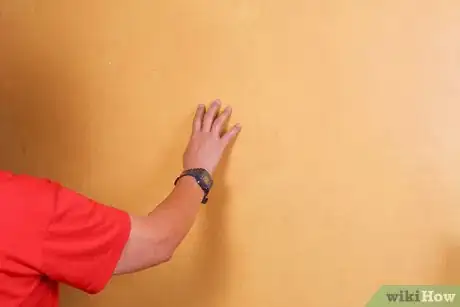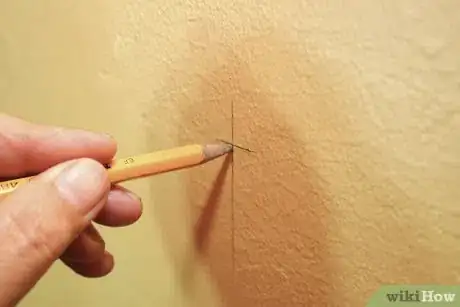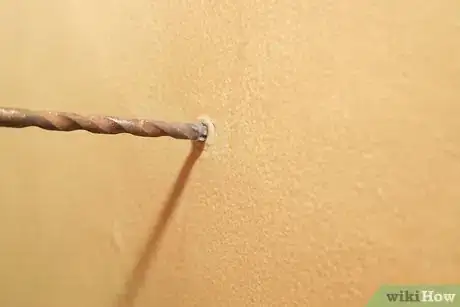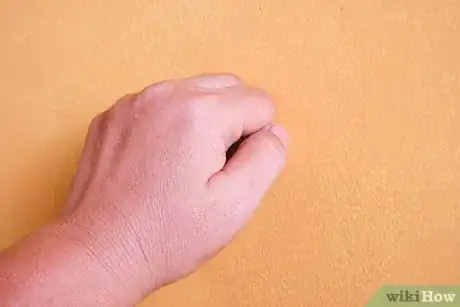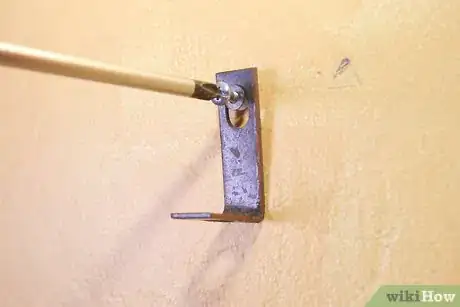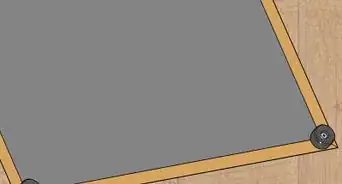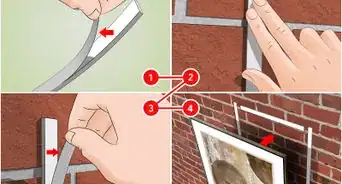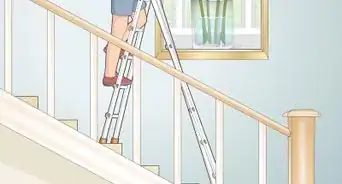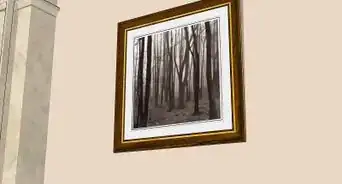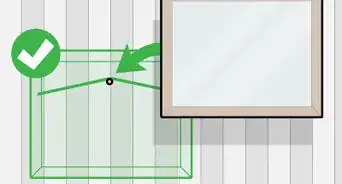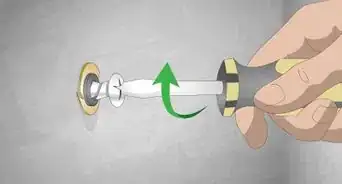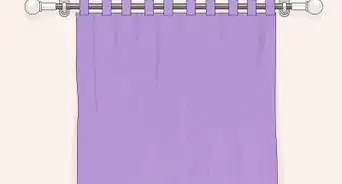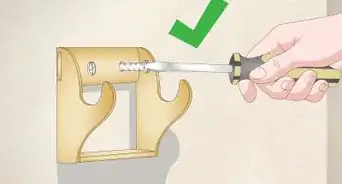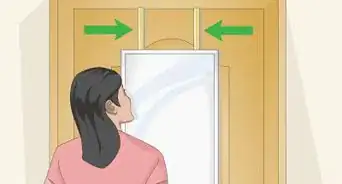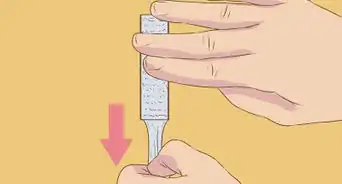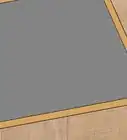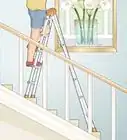wikiHow is a “wiki,” similar to Wikipedia, which means that many of our articles are co-written by multiple authors. To create this article, 9 people, some anonymous, worked to edit and improve it over time.
There are 8 references cited in this article, which can be found at the bottom of the page.
wikiHow marks an article as reader-approved once it receives enough positive feedback. In this case, several readers have written to tell us that this article was helpful to them, earning it our reader-approved status.
This article has been viewed 367,645 times.
Learn more...
The simplest way to hang pictures on the wall is to hammer a nail into the wall. Pictures that weigh over 20 lbs. (9.1 kg) are considered too heavy for hanging on a wall without proper reinforcement. To ensure that your picture doesn't come crashing down after you hang it, make sure you choose the proper tools and technique for a heavier picture. Once you properly hang a heavy picture, you will be well-equipped to hang your walls with heavy mirrors, shelving and speaker brackets, and other decorative elements.
Steps
Preparing to Hang Your Picture
-
1Weigh your picture. The weight of your painting will determine what fasteners and technique you will use to attach it to your wall. Heavier pictures and mirrors require special materials based on their weight. Use a regular bathroom scale to determine the exact weight of your picture.
- Pictures up to 10lbs are considered light loads, 10-25lbs are considered medium loads, and 25-50lbs are heavy loads. Check the packaging on the wall fasteners before using, as they will usually give a weight range for intended use. [1]
-
2Determine the kind of wall you are using. Older homes from the 1940s or earlier tend to have plaster walls. Most modern homes use drywall. [2] You can also hang heavy pictures on brick, mortar, and ceramic tile with the necessary tools and approach.Advertisement
-
3Decide where to hang your picture. Find a spot where you would like to hang your picture or mirror and hold it against the wall. Consider hanging your picture at eye-level height as a general rule of thumb. Mark the top of the frame with a pencil or a piece of painter's tape. [3]
-
4Mark where you will drill or nail your wall fastener. Use a measuring tape to determine what point on the wall to hang your picture from. Depending on the kind of frame you are hanging, the frame may hang lower on the fastener.
- If the frame has a D-ring or other metal loop on the back, simply measure from the top of the frame to the height of the ring. Measure this distance down from the mark you made on the wall with pencil or painter's tape. Mark this new spot in pencil with an X. This will be where you drill or nail a fastener into the wall. [4]
- If the frame has a wire across the back, pull up on the wire with the tape measure to it's highest possible point. Measure from this point to the top of the frame. Remove the tape measure and measure this distance down from the original mark you made on the wall with pencil or painter's tape. Mark this new spot in pencil with an X. This will be where you drill or nail a fastener into the wall. [5]
-
5Add a second hanging point. For added strength, consider hanging the picture from two points in the wall. This is especially recommended for heavy loads. If the frame hangs from a wire, use two fingers to hold the wire at the desired hanging points. The farther apart they are, the more stable the painting will hang. Measure from these two points with a tape measure to the top of the frame and transfer the measurement to the wall using a pencil.
- You can also hold a scrap piece of wood about half the width of the frame under the hanging wire to determine the two hanging points. The two corners of the wood will be where you will hang the fasteners. Measure the distance between the wood and the top of the frame using a tape measure and place the wood on the wall underneath your original mark using that measure. Using a level to make sure it is even, draw a line across the top of the wood. The two end points of the line will be where you hang your two fasteners.
Hanging a Picture on Drywall and Plaster
-
1Hang your picture on a stud. For heavier pictures, it is best to hang your picture on a stud. Drywall has a stud, or wooden support brace, about every 16 inches (40.6 cm). Find a wall stud using a stud finder, or by gently tapping the wall until you hear a solid, rather than a hollow, sound. Plaster walls are more difficult to find studs, so consider another method if you have trouble.
- If your picture is wider than 16 inches (40.6 cm), or the distance between two studs in your wall, Use a level and two screws to screw a narrow piece of wood into the wall. Make sure the screws are in at least two studs, for extra strength. You can then fasten picture hangers into the wood at desired intervals using nails or screws, depending on what the fastener requires. Hang the picture across both picture hangers. [6]
- If your picture is narrower, use a mounting picture hanger to hang it from one point on the wall stud. Choose a hanger that uses several nails for added strength. Hammer the nails into the wall stud, then hang your picture on the hanger. [7] If hanging on a plaster wall, make sure you use a hanger that uses screws, not nails.
- It is unlikely that you will want to hang your picture exactly where you have studs in your wall. There are other strong, reliable methods for hanging pictures if you do not find a desired wall spot for your picture with a wall stud behind it.
-
2Use traditional picture hangers. While traditional picture hangers may not seem like the most sturdy option, they are easy to use and cause minimal damage to your wall. Picture hangers with one nail can hold up to 25lbs, and hangers with two nails can hold up to 50lbs. While it is not recommended that you push the limits of these hangers, you may use them for medium load paintings. You can use them on plaster as long as the hangers have screws or anchor screws. [8]
- Hammer or screw the picture hanger into the wall at the desired spot using the corresponding number of nails or screws. Hang your picture on this hanger.
-
3Use anchor bolts to hang your picture. There are many different kinds of anchor bolts depending on the weight of your picture and the type of wall you are using. All anchors require pilot holes. You will need to drill a preliminary hole into the wall before inserting the bolt or screw and hanging the picture. You must use anchor bolts and screws with plaster walls. Using nails and hammers on plaster will only cause damage to the wall.
- Plastic anchor screws are surrounded by plastic that expand into the wall after you screw them in. For drywall, choose ones with plastic wings that expand out behind the wall. Plastic anchor screws without wings work best on plaster walls, as they grip the plaster well. Drill a hole the diameter of the anchor. Insert the anchor into the hole and pull it back out. Screw it back into place to activate the plastic anchor. Screw it back out and attach a picture hanger, then screw it back in to secure it. You may also unscrew the anchor screw to the desired length and simply hang the picture from the hook it forms. [9]
- Molly bolts are more difficult to use but hold heavy loads well. This kind of anchor bolt provides support by gripping the back of the wall. Drill a hole the diameter of the molly bolt. Insert the bolt and then tighten with the drill. The metal support behind the bolt will flare out on the other side of the drywall as you tighten the screw. Unscrew and attach a picture hanger, or simply hang the picture from the screw. [10]
-
4Provide heavyweight support with a toggle bolt. Toggle bolts hold the greatest amount of weight. They are spring-loaded and provide support from the back of the wall. They are also the best choice for plaster walls. They require a much wider drill bit to install.
- Drill a hole the diameter of the folded toggle bolt. Fold down the spring-loaded wings and insert the bolt into the hole. Let go and the wings will spread out behind the drywall. Pull it back out and tighten with a drill. You can hang a picture hanger from the screw, or hang the picture directly from the screw. [11]
Community Q&A
-
QuestionMy picture is 13.5 lbs. What should I use to hang it? Is an eyelet and picture wire strong enough?
 Community AnswerYes. I have that holding up a 15 lb mirror in my room. It is definitely strong enough.
Community AnswerYes. I have that holding up a 15 lb mirror in my room. It is definitely strong enough. -
QuestionHow do I hang heavy mirrors on reinforced concrete walls?
 Community AnswerBoth the mirror and the installation need to be protected by proper mounting technique. There are mirror mounting brackets, which you can obtain from a home store or form local glass suppliers, which grab the edges of the glass once they are installed. There is a framework behind which is bolted or screwed to the wall. You will need a masonry bit and some luck to avoid hitting any reinforcing in the wall.
Community AnswerBoth the mirror and the installation need to be protected by proper mounting technique. There are mirror mounting brackets, which you can obtain from a home store or form local glass suppliers, which grab the edges of the glass once they are installed. There is a framework behind which is bolted or screwed to the wall. You will need a masonry bit and some luck to avoid hitting any reinforcing in the wall. -
QuestionHow can I position the wire?
 Community AnswerIf you are using a nail, put a fork on that nail then put the picture on and remove the fork.
Community AnswerIf you are using a nail, put a fork on that nail then put the picture on and remove the fork.
References
- ↑ http://www.thisoldhouse.com/toh/photos/0,,20403461_20813027,00.html
- ↑ http://www.thisoldhouse.com/toh/video/0,,20802905,00.html
- ↑ http://www.lowes.com/projects/decorate-and-entertain/hang-pictures-on-a-wall/project
- ↑ http://www.lowes.com/projects/decorate-and-entertain/hang-pictures-on-a-wall/project
- ↑ http://www.lowes.com/projects/decorate-and-entertain/hang-pictures-on-a-wall/project
- ↑ http://www.nytimes.com/1983/03/20/nyregion/home-clinic-hang-heavy-pictures-and-mirrors-with-an-eye-to-safety.html
- ↑ http://www.lowes.com/projects/decorate-and-entertain/hang-pictures-on-a-wall/project
- ↑ http://www.ronhazelton.com/projects/how_to_hang_heavy_objects_on_walls
- ↑ http://www.thisoldhouse.com/toh/photos/0,,20403461_20813027,00.html
- ↑ http://www.ronhazelton.com/projects/how_to_hang_heavy_objects_on_walls
- ↑ http://www.thisoldhouse.com/toh/video/0,,20802905,00.html
- ↑ http://www.bobvila.com/articles/how-to-hang-a-heavy-mirror/#.VgYl7u1Viko
- ↑ http://www.popularmechanics.com/home/interior-projects/how-to/a3122/the-proper-way-to-hang-a-picture-10792209/
About This Article
If you want to hang a heavy picture on drywall and plaster, try your best to find a stud in the wall near where you want the picture to hang. Anchoring your picture to a stud will give it the best possible support, since it’s a lot stronger than just drywall. Studs are spaced about every 16 inches behind a wall, so gently tap on the wall until you hear a solid sound, rather than a hollow one. In the case where your studs aren’t where you want your picture to be, screw a traditional picture hanger into the drywall to hang pictures that weigh 25 pounds or less. For pictures that weigh up to 50 pounds, you can use 2 hangers spaced evenly along the back of the picture. To hang really heavy pictures on plaster walls, use a toggle bolt by drilling a hole in the wall, pushing the bolt’s wings into the hole, and tightening the screw. For more help, including how to install molly bolts, read on.

